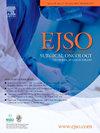脂肪肝移植治疗肝癌的预后和危险因素:一项多中心研究
IF 3.5
2区 医学
Q2 ONCOLOGY
引用次数: 0
摘要
越来越多的脂肪变性移植物用于肝移植(LT),包括肝细胞癌(HCC)患者。然而,脂肪变性移植物对HCC受者预后的影响尚不清楚。本研究旨在评估脂肪变性移植物对HCC受者长期预后的影响,并开发一种最小化此类移植物风险的算法。材料与方法分析联合器官共享网络数据库中2003 - 2022年肝细胞癌行肝移植患者的临床病理资料。倾向评分匹配(PSM)后,比较非脂肪变性(大脂肪变性≥30%)和脂肪变性(大脂肪变性≥30%)移植组受者的无病生存期(DFS)和总生存期(OS)。进行相互作用分析以确定放大脂肪变性移植物对DFS的负面影响的因素。结果共纳入符合条件的HCC患者8345例。三个因素对脂肪变性移植物有显著的交互作用:冷缺血时间≥6h (HR = 1.447;P = 0.023),供体质量指数≥40 (HR = 1.771;P = 0.018)和非酒精性脂肪肝患者(HR = 1.632;p = 0.032)。大脂肪变性肝相关危险(HAML)评分是基于这三个因素创建的。在HAML≥1的队列中,脂肪变性移植组的DFS和OS较非脂肪变性移植组显著降低。而在HAML = 0组中,两组患者的DFS和OS无显著差异。结论通过HAML评分可降低肝细胞肝癌肝移植的风险。本文章由计算机程序翻译,如有差异,请以英文原文为准。
Outcomes and risk factors for liver transplantation using steatotic grafts for hepatocellular carcinoma: a multicenter study
Introduction
A growing number of steatotic grafts have been used in liver transplantation (LT), including hepatocellular carcinoma (HCC) patients. However, the impact of steatotic grafts on the prognosis of HCC recipients remains unclear. This study aims to evaluate the impact of steatotic graft in long-term prognosis for HCC recipients and development an algorithm for minimizing the risk of these grafts.
Materials and methods
The clinicopathologic data of HCC patients undergoing LT from 2003 to 2022 in the United Network for Organ Sharing database was analyzed. The disease-free survival (DFS) and overall survival (OS) of recipients were compared between non-steatotic (macrosteatosis <30 %) and steatotic (macrosteatosis ≥30 %) graft groups after propensity score matching (PSM). Interaction analysis was conducted to identify factors that amplified the negative impact of steatotic grafts on DFS.
Results
A total of 8345 eligible HCC patients were included. Three factors exhibited significant interaction effect with steatotic grafts: cold ischemia time ≥6h (HR = 1.447; P = 0.023), donor body mass index ≥40 (HR = 1.771; P = 0.018) and recipient with non-alcoholic fatty liver disease (HR = 1.632; P = 0.032). Hazard Associated with Macrosteatotic Liver (HAML) score was created based on these three factors. In HAML ≥1 cohort, the DFS and OS of steatotic graft group were significantly reduced compared to non-steatotic graft group. But in HAML = 0 cohort, no significant differences in DFS and OS were observed between the two groups.
Conclusions
The risk of steatotic grafts in LT for HCC could be minimized through evaluating HAML score.
求助全文
通过发布文献求助,成功后即可免费获取论文全文。
去求助
来源期刊

Ejso
医学-外科
CiteScore
6.40
自引率
2.60%
发文量
1148
审稿时长
41 days
期刊介绍:
JSO - European Journal of Surgical Oncology ("the Journal of Cancer Surgery") is the Official Journal of the European Society of Surgical Oncology and BASO ~ the Association for Cancer Surgery.
The EJSO aims to advance surgical oncology research and practice through the publication of original research articles, review articles, editorials, debates and correspondence.
 求助内容:
求助内容: 应助结果提醒方式:
应助结果提醒方式:


